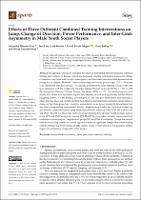Please use this identifier to cite or link to this item:
https://repositorio.usj.es/handle/123456789/773
| Title: | Effects of Three Different Combined Training Interventions on Jump, Change of Direction, Power Performance, and Inter-Limb Asymmetry in Male Youth Soccer Players |
| Authors: | Moreno-Azze, Alejandro Arjol-Serrano, José Luis 
Falcon-Miguel, David 

Bishop, Chris John 

Gonzalo-Skok, Óliver 

|
| Keywords: | Between-limbs; Asymmetryinjury; Preventionresistance training |
| Issue Date: | 24-Nov-2021 |
| Publisher: | MDPIST ALBAN-ANLAGE 66, CH-4052 BASEL, SWITZERLAND |
| Citation: | Moreno-Azze, A.; Arjol-Serrano, J.L.; Falcón-Miguel, D.; Bishop, C.; Gonzalo-Skok, O. Effects of Three Different Combined Training Interventions on Jump, Change of Direction, Power Performance, and Inter-Limb Asymmetry in Male Youth Soccer Players. Sports 2021, 9, 158. https://doi.org/10.3390/sports9120158 |
| Abstract: | Background: This study compared the effects of performing different unilateral combined training interventions on diverse vertical and horizontal jumping performance parameters, change of direction, concentric and eccentric mean power, and their associated inter-limb asymmetries in young soccer players. Methods: Forty-seven young male soccer players (age: 15.5 +/- 0.9 years) were distributed into three groups. Two groups performed the same training volume with both legs, beginning with the weaker leg (Stronger Volume Weaker leg group (SVW), n = 14) or with the stronger leg (Stronger Volume Stronger leg group, (SVS), n = 15). The third group executed double the volume with the weaker leg and also commenced with such leg (Double Volume Weaker leg group (DVW), n = 16) during a 10-week period. Pre- and post-intervention tests included a single-leg hop, single-leg lateral hop, triple hop, bilateral and unilateral countermovement jumps, a change of direction speed test, concentric and eccentric mean power during the lateral squat test, and their corresponding asymmetries. Results: Single-leg hop weaker leg, triple hop weaker leg, and bilateral countermovement jump improvements were achieved in the SVW (ES: 0.29 to 0.46) and DVW (ES: 0.55 to 0.73) groups. Between-groups analysis showed better results in single-leg hop in the SVW and DVW compared to group SVS. The DVW group achieved better improvements in countermovement jump in comparison to groups SVS and SVW. Conclusions: Groups that started with the weaker leg seemed to achieve a greater volume of significant changes than when starting with the stronger leg. Performing a double volume on the weaker limb does not guarantee further improved performance compared to other groups. |
| URI: | https://repositorio.usj.es/handle/123456789/773 |
| ISSN: | 2075-4663 |
| Appears in Collections: | Artículos de revistas |
Files in This Item:
| File | Description | Size | Format | |
|---|---|---|---|---|
| Effects of Three Different Combined Training Interventions.pdf | 1,54 MB | Adobe PDF |  View/Open |
This item is licensed under a Creative Commons License

